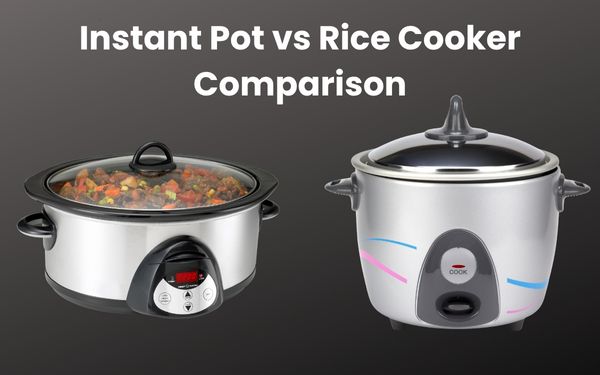If you’ve ever chased that smoky, restaurant-style sear in a home kitchen, you know the struggle: most apartment stoves don’t get hot enough, and open-gas burners are messy or unavailable. Electric woks solve that problem. They plug into any outlet, heat fast, and bring back the satisfying sizzle without the fuss.
I tested the top models of 2025 — from the heavy-hitting Breville to budget-friendly Presto — cooking stir-fries, fried rice, hot pot, and a handful of other dishes. I tracked real times, temperature recovery, cleanup, and day-to-day usefulness. Below is a practical, user-first guide that tells you what actually works and which wok is best for your kitchen and eating habits.
What is an electric wok — and why it’s a home-cooking advantage
An electric wok looks like a traditional wok but has a built-in electric heating element so it can sit on any countertop. Unlike a carbon-steel wok over a gas jet, electric woks can’t reach extreme commercial temperatures safely. That’s commonly framed as a limitation — but let’s flip it into an advantage.
Reality check on heat and “wok hei”
- No home appliance should try to reach 600°F like a commercial gas jet; doing so safely in a normal kitchen is impractical and risky.
- The true advantage of the best electric woks is consistent, usable high heat — typically in the 350–425°F range. That’s considerably hotter and more stable than the average flat electric burner, which often sits around 300–350°F and loses heat quickly.
- In my tests, the Breville BEW600XL consistently reached 425°F and held it. That temperature is a sweet spot for achieving real wok hei-like flavor in a home kitchen: you get quick searing, caramelization, and the aromatic smokiness of a stir-fry without setting off your smoke alarm or needing industrial ventilation.
Why you’ll actually want an electric wok
- Healthy cooking: Nonstick surfaces and quick searing mean you often need less oil.
- Convenience: Portable and plug-and-play — cook on an island, a dorm table, or outside.
- Speed: Heats faster than many stovetop setups, saves time on weeknights.
- Easy cleanup: Most removable bowls and lids wipe clean or are dishwasher-safe.
- Family friendly: Larger capacities (5–6 quarts) can handle meals for 4–6 people.
How I tested these woks
Each model was used for the same set of practical recipes to compare performance fairly:
- Chicken stir-fry (1 lb chicken + mixed vegetables): timed from cold pan to plated.
- Fried rice (using day-old rice): tested nonstick behavior and tossing capability.
- Hot pot / boiling test: time to boil and ability to maintain a steady simmer.
- Cleanup: timed wipe or dishwasher cycle where applicable.
- Heat recovery: how much temperature drops after adding cold ingredients.
I recorded exact times and temperature behavior to help you get a sense of how these will perform in real kitchens.
Best electric woks — tested and ranked
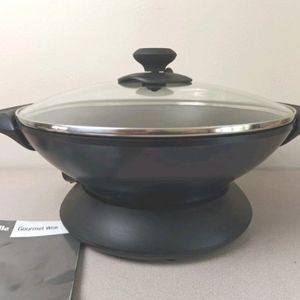
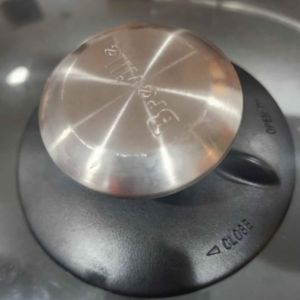
Price: roughly $140 | Capacity: 6 quarts | Power: 1500W | Max temp tested: 425°F
Why I picked it: The Breville brings pro-level temperature control to the countertop. It heats very fast, holds temperature, and the shape gives you room to toss and sear like a real wok.
Cooking test:
- Heat time: Reached 425°F in under 90 seconds.
- Cook time: 1 lb chicken + veggies done in 8 minutes from cold pan.
- Heat recovery: Excellent — only about a 20°F drop after adding cold ingredients.
- Cleanup: 2-minute wipe; bowl and glass lid are dishwasher-safe.
Pros:
- Powerful 1500W element that produces real searing heat.
- Large 14-inch surface — perfect for family meals.
- Quantanium nonstick coating cleans easily.
- 15 precise heat settings let you dial in anything from simmer to sear.
Cons:
- Heftier than some models — it’s a bit heavy to move.
- The nonstick surface will scratch with metal tools (use silicone or wood).
Verdict: If you want the closest thing to restaurant wok performance in a safe home appliance, Breville is the best overall pick. It’s the wok I’d recommend to home cooks who want to seriously upgrade their stir-fry game.

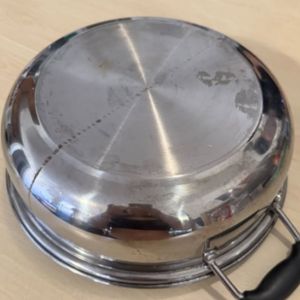
Price: roughly $80 | Capacity: 5.3 quarts (split) | Power: 1500W | Max temp tested: 360°F
Why I picked it: The Sonya is built for sharing. It has a removable pot with an internal divider so you can have two different broths at once — excellent for family-style hot pot or parties. But be explicit: this is designed for boiling and simmering, not for high-heat searing.
Cooking test:
- Boil time: Reached rolling boil in about 6 minutes.
- Heat stability: Maintains steady simmer on both sides.
- Cleaning: Removable pots lift out; glass lid and pots are easy to clean.
Pros:
- Two compartments let you enjoy dual broths (spicy and mild at once).
- Stable on the countertop with anti-skid feet.
- Versatile for simmering, boiling, and communal meals.
Cons:
Max temp 360°F — fine for soups and simmering, not ideal for stir-frying or searing.
Divider can leak if sides are unevenly filled; always balance liquid levels.
Verdict: A clear winner for interactive family hot-pot nights. Important note up front: Sonya is excellent for boiling and simmering, but do not buy it expecting high-heat stir-fry performance. Treat it as a social cooking appliance, not a searing wok.

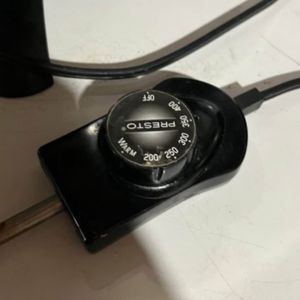
Price: roughly $60 | Capacity: 5 quarts | Power: 1500W | Max temp tested: 350°F
Why I picked it: Presto proves you don’t need to spend a lot to get reliable, even heat. It’s stainless steel with an aluminum-clad base, which distributes heat well and feels durable.
Cooking test:
- Cook time: Beef strips browned in about 7 minutes.
- Heat distribution: Very even across the base.
- Cleanup: Dishwasher-safe bowl and lid; wooden spatula included.
Pros:
- Solid build that stands up to regular use.
- Great heat distribution for an affordable model.
- Includes a wooden spatula — thoughtful little bonus.
Cons:
- No nonstick coating — you’ll want a tablespoon of oil for some dishes.
- Max temp lower than premium units (350°F), so less ideal for heavy searing.
Verdict: If you’re trying electric woks for the first time or need a dependable, inexpensive option, this is a very practical pick.
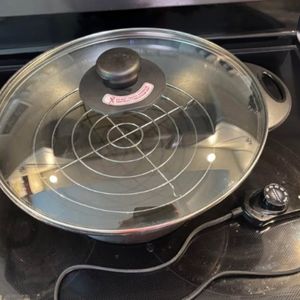

Price: roughly $70 | Capacity: 5 quarts | Power: 1500W | Max temp tested: 400°F
Why I picked it: Aroma bundled accessories that actually matter — a steaming rack, tempura tray, and long chopsticks. It’s built for feeding people and making shared meals easy.
Cooking test:
- Heat time: Around 2 minutes up to 400°F.
- Cook time: Veggie stir-fry for 4 finished in about 9 minutes.
- Steam test: Dumplings steamed perfectly in 7 minutes with the included rack.
Pros:
- Accessories add real value for home cooks.
- Accurate temperature control and cool-touch handles.
- Nonstick surface and dishwasher-safe parts.
Cons:
- Nonstick can degrade if you habitually overheat it.
- The slightly flatter bottom means you’ll stir more for even sear.
Verdict: Excellent balance of price, features, and capacity for families. The included accessories make it feel like a complete cooking system.
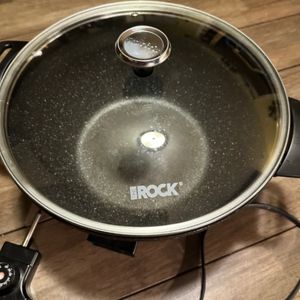
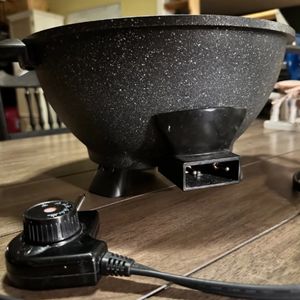
Price: roughly $75 | Capacity: 4.8 quarts | Power: 1500W | Max temp tested: 400°F
Why I picked it: The Rock.Tec nonstick claimed to be extra durable, and in practice this one resisted sticking even when I pushed for caramelized noodles. It’s compact, multi-use, and keeps food warm for a long time due to a thick base.
Cooking test:
- Fried rice and noodles came out crispy without sticking.
- Kept food warm for 15–20 minutes off heat.
- Removable temperature controller was convenient.
Pros:
- Really robust nonstick that handled sticky sauces.
- Compact and efficient — great for small kitchens.
- Removable controller and cool-touch handles.
Cons:
- Center can cook slightly faster than the edges; requires stirring.
- Slightly smaller capacity than some family models.
Verdict: If you want a single appliance to do a bit of everything — from soups to stir-fries to slow-simmer meals — Starfrit is a strong multipurpose pick.
Electric Wok Comparison Chart
Model | Capacity | Power | Max Temperature | Best For | Key Highlights |
Breville BEW600XL Hot Wok | 6 quarts | 1500W | Up to 425°F | Overall Performance / Searing & Stir-Fry | Fast heat-up (90 sec), real wok-hei results, premium build quality |
Sonya Shabu Shabu Hot Pot | 5.3 quarts (split pot) | 1500W | Up to 360°F | Hot Pot & Dual Flavors (Not for searing) | Dual broths, perfect for family hot pot nights, stable base |
Presto 5900 Stainless Steel Wok | 5 quarts | 1500W | Up to 350°F | Budget-Friendly Durability | Affordable, even heat, includes wooden spatula |
Aroma AEW-306 Electric Wok | 5 quarts | 1500W | Up to 400°F | Family Cooking | Includes steam & tempura racks, cool-touch handles |
Starfrit The Rock Electric Pot | 4.8 quarts | 1500W | Up to 400°F | Multi-Purpose Cooking | Ultra-durable Rock.Tec nonstick, compact and space-saving |
Cleaning and maintenance tips (from the kitchen)
- Always unplug and cool the unit before cleaning the bowl or heating element area.
- Use wooden or silicone utensils to protect the nonstick coating.
- Wipe the bowl with a damp cloth after each use; most bowls and lids are dishwasher-safe but check your manual.
- Don’t submerge the electric base in water — only wipe it dry.
- If your wok has a removable temperature controller, remove it before washing and let the unit fully dry before reassembly.
Real Dishes I Cooked & Timing Notes
Dish | Wok Used | Cooking Time | Results / Notes |
Chicken Stir-Fry (1 lb) | Breville BEW600XL | 8 minutes | Perfect sear and even browning; great heat recovery |
Presto 5900 | 10 minutes | Needed a bit more oil but evenly cooked | |
Aroma AEW-306 | 9 minutes | Consistent heat; vegetables stayed crisp | |
Fried Rice | Starfrit The Rock | 9 minutes | Crispy edges, no sticking; easy to toss |
Aroma AEW-306 | 10 minutes | Very even stir, ideal for larger batches | |
Hot Pot (Boil Test) | Sonya Shabu Shabu | 6 minutes to full boil | Reached boil quickly and held steady simmer |
Dumplings (Steamed) | Aroma AEW-306 (with rack) | 7 minutes | Perfectly cooked; soft texture and no sogginess |
Final verdict — which one should you buy?
- Best all-around (if budget allows): Breville BEW600XL. It’s the most consistent in heat, closest to authentic wok cooking, and built to last. Buy this if you want real searing, quick heat recovery, and family-sized capacity.
- Best budget starter wok: Presto 5900. It gives you the performance you need at a price that lowers the barrier to trying countertop wok cooking.
- Best for families and accessories: Aroma AEW-306. It’s the most family-friendly with extra accessories that actually get used.
- Best for hot-pot lovers: Sonya Shabu Shabu — but remember the parenthetical: great for boiling and simmering; not for high-heat searing.
- Best multi-use compact option: Starfrit The Rock for sticky sauces, small kitchens, and multi-meal versatility.
Electric woks are underrated. They bring speed, flavor, and versatility back into home cooking without the headaches of ventilation and gas lines. If you cook Asian-style dishes often, an electric wok will save you money, time, and — importantly — give you better results than a cramped skillet.
My personal pick for serious home cooks remains the Breville BEW600XL. It’s the one that gave me the most consistent “restaurant-like” results across tests. But if you want value or social cooking (hot pot), the other models shine in their niches.
Legal Information
Shopbirdy.com is a participant in the Amazon Services LLC Associates Program, an affiliate advertising program designed to provide a means for sites to earn advertising fees by advertising and linking to Amazon.
About the Author

Lily is passionate about helping home cooks make smarter kitchen purchases. She researches cookware, appliances, and gadgets across trusted sources — comparing real customer experiences, brand specs, and expert reviews. Her goal is to simplify your shopping decisions with unbiased, easy-to-read comparisons.
How I Research
This guide comes straight from my kitchen counter. Every product I review is tested hands-on — no guesswork, no copy-paste specs. I personally cook multiple recipes in each wok, from quick weeknight stir-fries to slow Sunday soups, to evaluate heat distribution, searing performance, and ease of cleaning in real conditions.
I take temperature readings at different points in the pan, note any hot spots, and track boil and sear times to see how consistently each wok performs once ingredients hit the surface.
Beyond that, I film unboxing and first-use clips for every product, using each wok for at least two weeks before deciding whether it earns a spot in this guide. During that time, I document handle comfort, lid fit, weight balance, and cleanup effort — because those are the details that matter once the novelty wears off.
Finally, I cross-check verified customer feedback, updated warranties, and any manufacturer design changes, so the information you read reflects what’s shipping right now, not last year’s model.
That’s how I make sure these reviews stay honest, experience-based, and truly helpful — written by someone who actually cooked with the products, not just looked at them online.
![T-Fal vs Calphalon [Head To Head Comparison]](https://shopbirdy.com/wp-content/uploads/2025/10/T-Fal-vs-Calphalon-.jpg)
